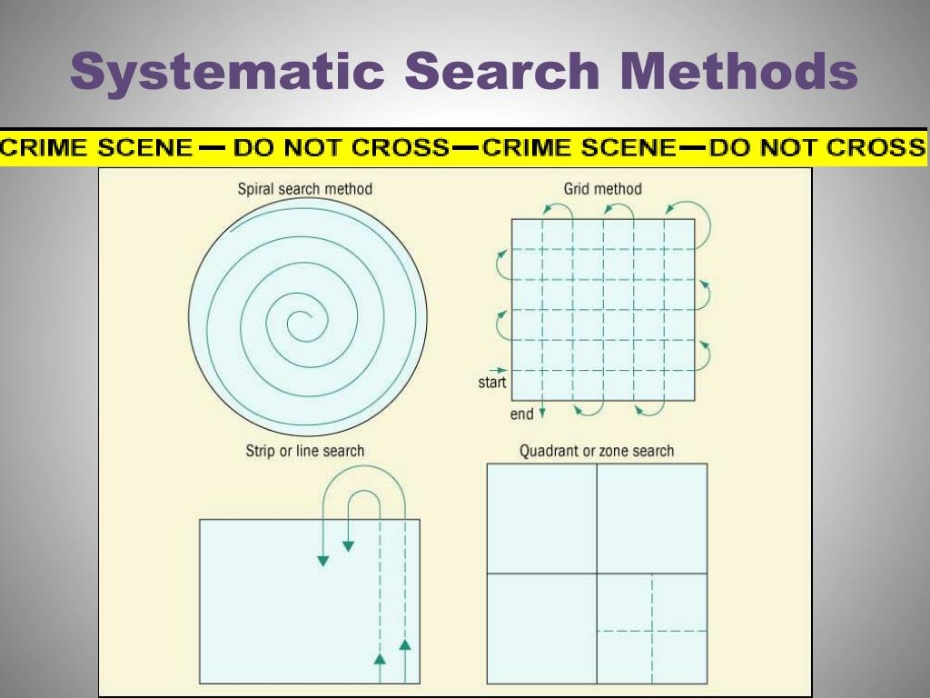
CRIME SCENE SEARCH METHODS
- By Ms. Kashish Goyal
Abstract:
An essential component of any investigation is the examination of the crime scene. It is the place where logic, science, and law converge. Valuable documenting of the state or condition of the scene, as well as photography or videography of the location of the evidence, is done throughout the lengthy and tiresome process of a crime scene investigation. The gathering of any tangible proof that could dispel the obscurity. It shed light on what had occurred while identifying the how and who of it. There may not be a conventional criminal scene, a common frame of evidence or standard investigative strategy. The distinction between fieldwork and lab work is handled differently by each CSI unit. Criminal scene examiners are not forensic experts. Some forensic anthropologists work in
Introduction:
Identification and collection of tangible evidence at the crime site serve as the first steps in the investigation. Following investigation and development of the retrieved physical data,then moves on to present all findings to the court of law after gathering evidence, documentation, and witness statements. All members of the team, from the initial responders to the information's final consumers, should have a sufficient awareness of the forensic process, including identification, recovery, collection, preservation, transportation, and correct documentation to uphold the chain of custody. Crime scene investigation is a procedure that aims to document the scene since it is the initial point of contact as well as identify and gather all the physical evidence necessary to solve the case.
The exact spot or area where the incident occurred is known as the scene of the crime or place of occurrence. In most cases, police officers arrive at the crime scene first and start the investigation there. Initially, responding officers are the police officers who arrive on the scene first (FRO). The first responding officer (FRO) appropriately safeguards both the crime scene and any associated evidence. The success of the initial responding officer in correctly locating, segregating, and securing the evidence will determine the outcome of the whole inquiry (s). For the aim of safeguarding the area, certain forms of crime scene tape, rope, or barrier are used to create a restricted boundary around the crime scene. The major focus of a crime scene investigation is the identification and retrieval of tangible evidence. According to this viewpoint, the proper search technique (or techniques) must be used on those kinds of crime scenes. In the goal of investigating the crime scene, a variety of search strategies may be used. Some of them include the following:
A] STRIP METHOD
The whole region to be searched, conveniently separated into strips. One by one, each strip is thoroughly inspected. The procedure is repeated until the entire region has been searched.
B] SPIRAL METHOD
The searchers begin at one end (a location outside the murder scene) and proceed along the spiral's course until they reach the scene's centre.
C] ZONE METHOD
The crime scene is broken up into multiple sections, and each section is looked at separately. The large area is then neatly split into smaller squares, which are all meticulously searched.
D] GRID METHOD
The searcher in the grid approach starts off like a strip search. He searches again at right angles to the initial strip after finishing the search along the horizontal lanes. This strategy of searching from two distinct perspectives aids in the recovery of evidence that the straightforward strip method could have overlooked.
E] WHEEL METHOD
The region is indicated as a circle in this search approach, or it is split into pie slices or wheel parts, often six in number.
Criminal scene investigators begin at the center and move outward along rays or straight lines.
Depending on the size of the region, repeat the procedure numerous times.
F] LINE METHOD
The line approach, which is similar to the grid search except for that searcher often only walks in one way, from one side of the search area to the other, is best employed outdoors. The line method search is the next best technique to utilize when a grid search may not be practical due to trees, plants, rocks, or other things.
Always keep in mind that protecting and maintaining the crime scene is where the hunt for any kind of evidence begins and finishes. The majority of the evidence may be located close to the victim, thus when choosing the sort of search to conduct, care should be given to pick one that won't disturb or otherwise interfere with the victim.
Conclusion
Any investigation must include a thorough examination of the crime scene. It is the place where logic, science, and law converge. Physical proof comprises any items that could prove or refute the commission of a crime, or connect a crime to its perpetrator or victim. At the crime scene, forensic science gets started. The evidence, in this case, has to be carefully preserved and identified for laboratory testing by the investigators. Securing the crime scene is the first responding officer's main responsibility. The appropriate investigators document the crime scene after it has been secured by taking pictures, sketching, and making notes. The investigator should undertake a preliminary assessment of the scene as it was left by the offender before processing the crime scene for tangible evidence.
Each unique object—or similar item gathered in several locations—must be put in its own container. Evidence is packaged individually to prevent harm. inhibits cross-contamination by touch. The chain of custody, which details the location of the evidence, must be kept in a record at the moment the evidence is collected.
Additionally, adequate standard/reference samples must be obtained from suitable people, such as hair, a buccal swab, and fiber, for comparison at the crime scene and in the lab. Any evidence that is taken from a person or a crime scene must be done so in compliance with the proper search and seizure procedures. Failure was caused by the investigator's lack of scientific expertise in the correct gathering, preservation, storage, and transfer of crime scene evidence.
References:
[1] Nabar, B. S, Forensic Science - In criminal Investigation, 3 rd ed. Asia Law House – 2015
[2] Sharma, B. R, Scientific Criminal Investigation, 2 nd ed. LexisNexis - 2018.
[3] Joe Nickell & John F. Fisher, Crime Science - Methods of forensic detection, The University Press of Kentucky - 1998.
[4] Evans C, Criminal Investigation: Crime Scene Investigation, Chelser House Publisher - 2009
Written BY:
Kashish Goyal [Intern I'd: AFRSIP 2316]
Christ University, Bangalore
MSC Forensic Science
